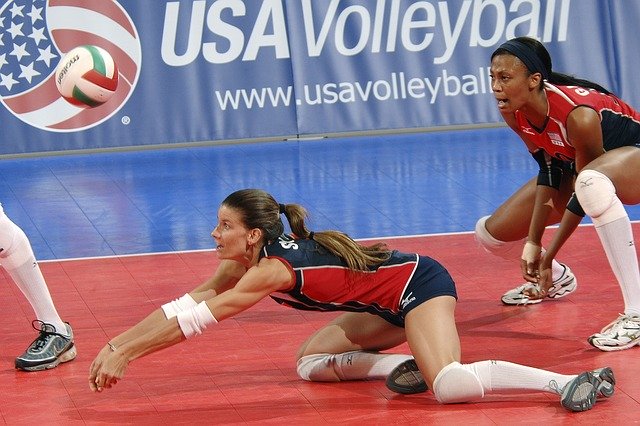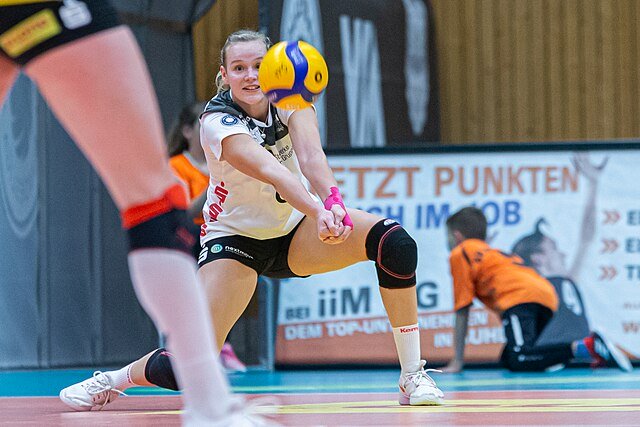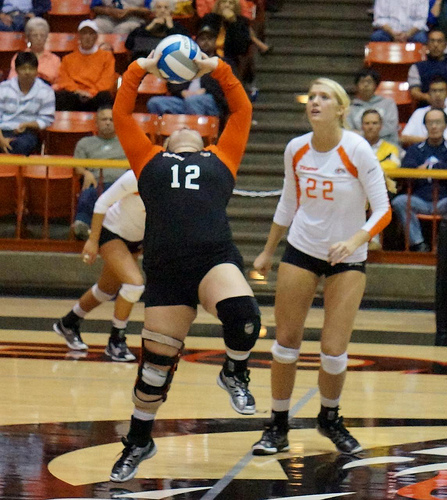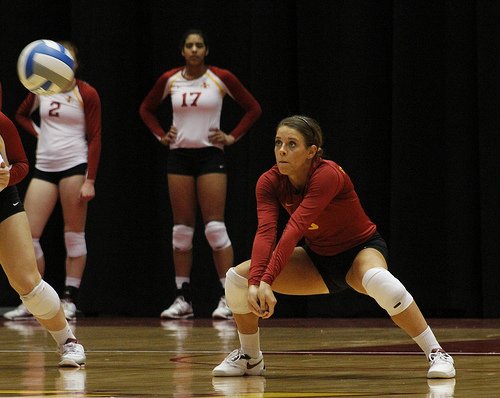- Improve Your Volleyball with Coach April
- Role Of Libero In Libero
- Libero Player in Volleyball
 Dear Volleyball Mom,
Do You Know What Sets My Private Volleyball Training Apart From Anyone In Vegas?
I invite You to read what my private volleyball training mission says before considering hiring me as a private volleyball coach because I'm not available for everyone.
Dear Volleyball Mom,
Do You Know What Sets My Private Volleyball Training Apart From Anyone In Vegas?
I invite You to read what my private volleyball training mission says before considering hiring me as a private volleyball coach because I'm not available for everyone.Good Setting Hands Are Important For The Libero Player in Volleyball
One important skill for the libero player in volleyball is setting because when the setter digs a ball, the libero steps in to set to the front or back row.
 One important skill for the libero player in volleyball is setting because when the setter digs a ball, the libero steps in to set to the front or back row. (Stacy Sykora, USA Libero)
One important skill for the libero player in volleyball is setting because when the setter digs a ball, the libero steps in to set to the front or back row. (Stacy Sykora, USA Libero)The libero player in volleyball plays a crucial role in setting during transition plays. When the setter digs a ball, the libero steps in to take over the setting responsibilities.
This is an important aspect of the libero's role, as they are skilled in quickly transitioning from defense to offense and making accurate sets to the front or back row players.
"File:2019-12-21 Volleyball, 1. Bundesliga Frauen, VfB 91 Suhl Lotto Thüringen - Schwarz-Weiss Erfurt IMG 2028 by Stepro.jpg" by Steffen Prößdorf is licensed under CC BY-SA 4.0 .
Their ability to set efficiently and effectively allows the team to continue their offensive attacks seamlessly.
Positioning is also a key factor for the libero in executing successful sets.
By being strategically positioned, the libero player in volleyball can anticipate where their teammates will be and deliver well-placed sets to optimize the team's offensive plays.
🛞⬆️✈️🏙️ pic.twitter.com/iBXnlyjdrB
— Nebraska Volleyball (@Huskervball) August 1, 2023
The libero's impact on the team's offensive strategy cannot be underestimated. Their presence enables the team to run versatile and dynamic plays.
With their excellent court vision and ability to read the game, the libero can quickly assess the situation and make split-second decisions on which player to set the ball to.
This allows for a variety of offensive options, including quick attacks, back-row hits, or even surprising the opposing team with unexpected sets.
Furthermore, the libero's ability to set effectively contributes to the team's overall rhythm and tempo.
By delivering well-timed and accurate sets, the libero helps the team maintain control of the game and establish their offensive flow.
They play a vital role in creating scoring opportunities for their teammates and building trust among the hitters by consistently delivering hittable balls.
By fulfilling their responsibilities as a setter, the libero enhances the team's offensive capabilities and contributes to their success on the court.
What Setting Tactics Can The Libero Player in Volleyball Use In Transition?
There are two specific tactics you can use, to control or change the speed of the game when you're playing volleyball.
The Libero Player in Volleyball Should Set The Ball High
In a perfect game, the libero or back row players would pass the ball to the designated setter, who would be the only player to set every second ball.
If the designated setter defends the first ball then she can't set the second one, someone else has to.
In this case, one of the most popular offensive volleyball tactics teams follow is that the libero steps in to set the ball.
It use to be commonplace that the right side hitter also known as the 'off side hitter' or "opposite" would step in to set the ball that a starting setter dug.
The Libero Player in Volleyball: Who Sets The Ball When The Setter Digs In Transition?
Nowadays, liberos playing volleyball are positioned in defense so that when the setter digs a ball, the libero steps in to set to the front or back row.
If this situation occurs, then it should not become a weak point in your team's offense.
To maintain control of the pace of the game the libero should be sure to get her knees, hips, shoulders and forehead lined up underneath the ball to get into position to set a nice high ball to her outsides or backrow hitters.
The libero player in volleyball should practice being as good a setter as the setters.
They should do alot of setting drills in practice because they are the second most likely player to set a ball on the court.
But when they do set, they're setting from the back row and especially in high school the setter needs to give a hittable ball to their potential hitters.
It's best not to risk increasing the speed of the game unnecessarily by shooting a fast set to the middle or outside.
The libero needs to help the team establish it's own rhythm by setting the ball high to the outside spiker or backrow hitter.
By doing this, the libero player in volleyball
- reduces the chances of committing unforced errors and
- increases the chances of building trust among their hitters by giving them hittable balls.
Here are some tips and techniques for effective setting as the libero player in volleyball:
1. Focus on Ball Control:
As a libero, your primary responsibility is to provide accurate and consistent sets to your teammates.
To achieve this, emphasis should be placed on developing excellent ball control skills.
Work on refining your hand positioning, footwork, and body control to ensure clean and precise contacts with the ball.
2. Quick Decision Making:
Setting as a libero often requires split-second decision making.
Be proactive in reading the game and anticipating the movement of your teammates.
This will help you make quick and informed decisions on which player to set and what type of set to deliver.
3. Adaptability and Versatility:
A successful libero should be able to set to various positions on the court.
Practice setting different types of balls, such as high sets, quick sets, and back-row sets.
This versatility will allow you to adjust to the situation and provide the most effective set for your teammates.
4. Communication:
Effective communication with your teammates is essential in setting.
Clearly communicate your intentions and provide information about the set you are delivering, such as calling "high" or "quick" to indicate the type of set.
This ensures your hitters are prepared and can approach the ball correctly.
5. Consistency in Placement:
Aim for consistency in your sets by focusing on repeatable and reliable positioning and technique.
Consistently placing the ball in the same location will allow your hitters to develop a rhythm and maximize their hitting efficiency.
6. Timing and Tempo:
Pay attention to the timing and tempo of your sets.
Varying the speed and tempo of your sets can keep the opposing team's defense off balance and create scoring opportunities for your team.
Practice sets with different speeds to develop the ability to adjust the rhythm of the game.
7. Practice with Different Scenarios:
Simulate game situations in practice by setting in various scenarios.
Work on setting from different angles, distances, and positions on the court.
This will help you adapt to different game situations and enhance your setting abilities.
8. Continuous Improvement:
As a libero, never stop improving your setting skills.
Seek feedback from coaches and teammates, watch videos of professional liberos, and analyze your own performances to identify areas for growth.
Continuously striving for improvement will make you a more effective and reliable setter.
By incorporating these tips and techniques into your training and gameplay, you can enhance your setting skills as a libero and better contribute to your team's offensive success.
Frequently Asked Questions about the Libero Player in Volleyball Position
Q: What is the role of a libero in volleyball?
A: The libero is a specialized player in volleyball who excels in defensive skills such as digging and passing. They primarily play in the backcourt and wear a contrasting color jersey to distinguish themselves from their teammates.
Q: When can a libero enter the game?
A: Liberos can freely enter and exit the game without counting towards traditional substitution limits. They typically replace a back-row player and play a crucial role in enhancing the team's defensive capabilities.
Q: Can a libero attack or hit the ball in the front row?
A: No, liberos are prohibited from hitting or attacking the ball in the front row. Their primary focus is on defense and setting when the setter digs a ball.
Q: What are the main skills that a libero should possess?
A: A good libero should have exceptional ball control, agility, and defensive skills. They should be quick and adept at reading the game, making accurate digs, and providing precise passes to set up their teammates for successful attacks.
Q: How does the libero position impact team strategy?
A: The libero's presence allows for optimized player rotations, heightened defensive strength, and smoother transitions from defense to offense. Their ability to specialize in defensive skills frees up other players to focus on their specific roles, improving overall team coordination.
Q: How has the libero position changed the game of volleyball?
A: The libero position has had a significant impact on volleyball by highlighting the importance of defense and spectacular defensive plays. It has created longer rallies, increased the strategic aspect of the game, and made matches more exciting for both players and spectators.
Q: Can a libero set the ball to any player on the court?
A: Yes, liberos can set the ball to any player on the court. However, they often focus on setting to the front or back row players when the setter is unable to do so.
Q: What is the purpose of the libero's contrasting color jersey?
A: The libero wears a contrasting color jersey to make them easily identifiable to the referee and differentiate them from their teammates on the court.
Q: Are liberos allowed to serve?
A: Yes, liberos are allowed to serve. They can utilize their defensive skills to make accurate and strategic serves, contributing to the team's overall performance.
Q: Can a libero be substituted for any player on the team?
A: Liberos are typically allowed to substitute for back-row players, often replacing a player who has rotated to the front row. The libero position provides flexibility in optimizing player rotations while maintaining a formidable defensive presence.
Remember, these answers provide a general overview of the libero position in volleyball. Rules and regulations may vary depending on the specific league or level of play.
The Libero Player in Volleyball:
Where Do You Go Now?
Okay here's where you need to go now! There are three options:
- Learn more about the Libero Volleyball Player by clicking the Related Links below. .
- Follow the suggested reading on our Sitemap page Learning How To Play (Sitemap)
SUSCRIBE
To My Email Newsletter Below!
From Lady Vol to Legend: Coach April Produces Powerful Passionate Players...is that you?
What Are You Looking For?

Hi there!
Thanks for stopping by. Hope you learned something today that will help you reach your volleyball goals.
Be sure to subscribe to my email newsletter so you can learn more each week!
Stay strong! Stay motivated!
-Coach April

SUSCRIBE
to my email newsletter below!
Vegas Volleyball's Unsung Heroes: Celebrating Moms with Peace Love Volleyball Shirts
Ready to energize your volleyball mom journey?
Subscribe to my 'Producing Powerful Passionate Peaceful Players' email list above on ImproveYourVolley.com.
You'll receive energy-boosting tips, exclusive insights from me, Coach April Chapple on maintaining momentum in volleyball.
Let's power up the Vegas volleyball scene together!
Recent Articles
-
Frequently Asked Libero Volleyball Position Questions Answered
Apr 14, 25 08:10 PM
I answer the most frequently asked libero volleyball position questions many players and coaches ask that will help you learn about the player responsibilities. -
Coach April's Peace Love Volleyball Phrases For T-Shirts Honor Moms
Apr 13, 25 03:49 PM
Whether on the court or in everyday life, April Chapple's volleyball phrases for t-shirts are serving inspiration for players and moms, one message at a time. -
What Is A Setter In Volleyball? My Setting Guide With Answers To FAQs
Apr 13, 25 12:36 AM
Learn what a volleyball setter is from a champion coach. Get expert insights, training tips, and proven strategies for volleyball's most strategic position.





























